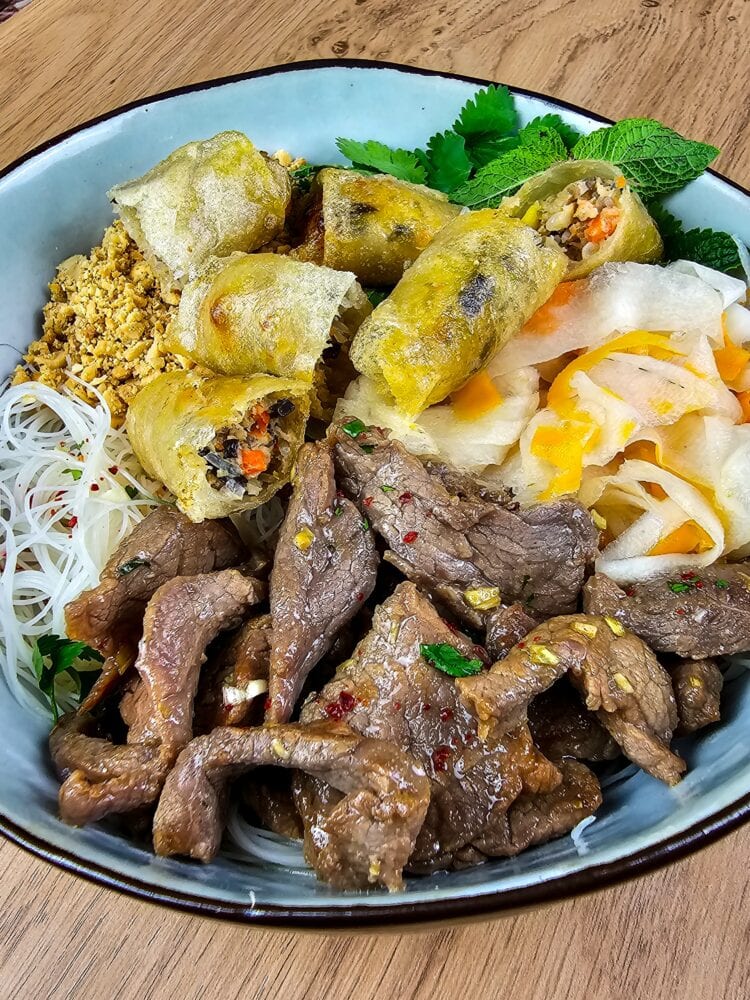What is Bo Bun?
Bo Bun, also known as Bún bò xào, is a Vietnamese noodle salad that deserves your full attention. This dish is much more than a simple salad; it’s a complete meal in itself, with a balanced combination of meat, starch, and vegetables. It’s a healthy Vietnamese version, with noodles, of the Korean bibimbap.
In the same vein, it has a distant cousin in the north called bun cha
At the heart of the bowl, you’ll find rice noodles (bún) served at room temperature, which form the base of this dish. They are accompanied by vegetables, often served cold, and tender pieces of beef (bò) that have been marinated in lemongrass and sautéed (xào) to perfection.
To top it all off, crispy spring rolls cut in half are added, along with fried onions, shallots, and garlic to give it crunch.
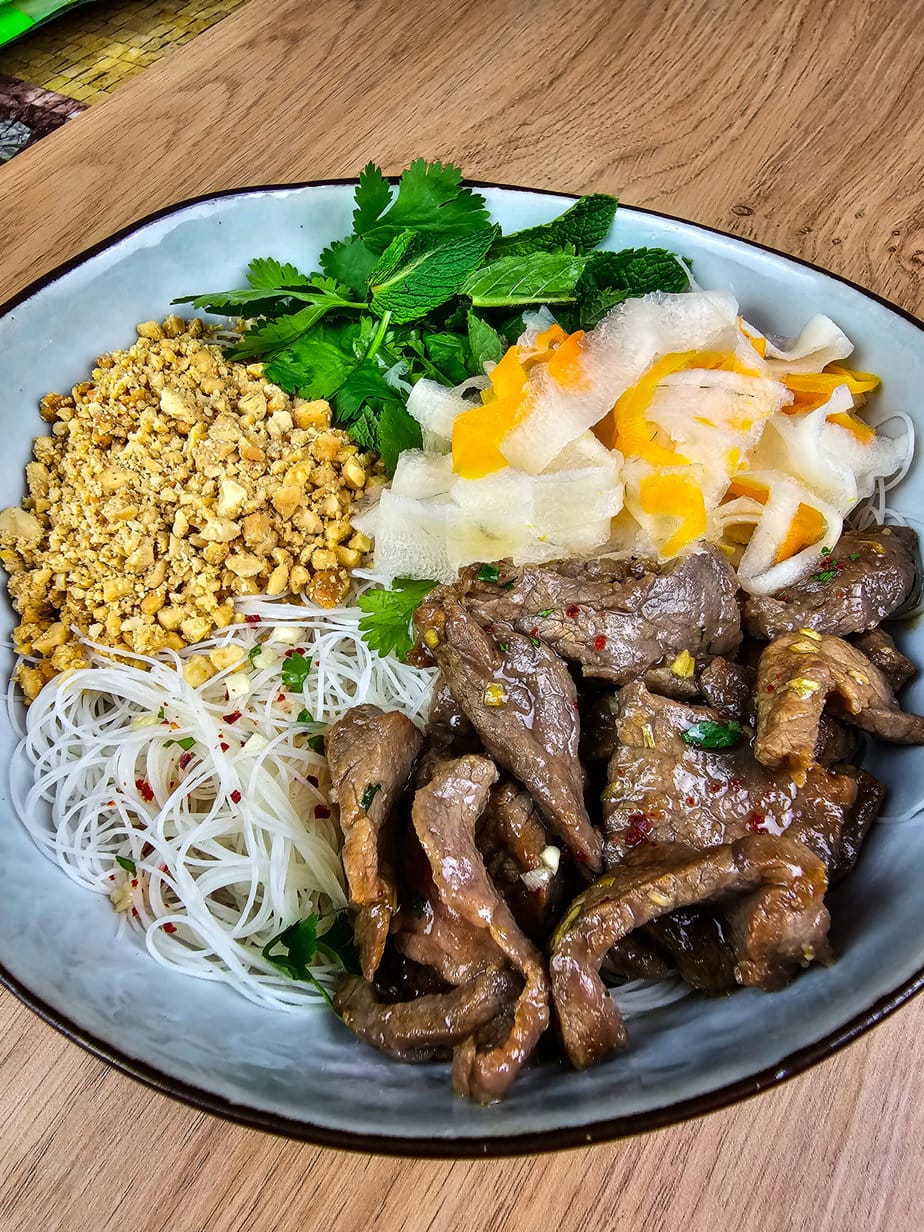
Crushed peanuts and a mix of fresh herbs like Thai basil, cilantro, and mint add an aromatic note. Don’t forget a generous dose of nuoc cham (nem sauce) that seasons the whole dish
Bo Bun, like banh xeo, is a thoughtful and harmonious dish that showcases the richness of Vietnamese cuisine. With its balance of textures and flavors, it proves to be not only nutritious but also extremely satisfying. It’s an excellent choice for those looking for a complete meal with a touch of culinary sophistication.
The Origin of Bo Bun
Rice noodle dishes mixed with savory sautéed meat have existed in southern Vietnam since at least the early 20th century. Historical accounts mention that as early as 1926, in Saigon (then in Cochinchina), vendors were offering bò bún – noodles served with grilled or sautéed beef and herbs – clearly specifying: ‘this is not bún bò, the special dish from Huế’. This suggests that southern Vietnam already had a tradition of noodles with sautéed meat (often called bún thịt xào, usually with pork) very similar to what we know today as bún bò Nam Bộ. Using beef instead of pork was simply a natural variation in some regions. Thus, in terms of style and flavor profile – fresh rice noodles topped with hot beef and fresh herbs, all accompanied by a sweet and sour fish sauce – the concept is rooted in southern Vietnamese cuisine.
Ironically, the dish became famous under the name ‘bún bò Nam Bộ’ in Hanoi. According to local tradition, it was created in the early 1980s by a street vendor named Madame Can. She originally sold bún chả (grilled pork noodles), but at the request of some customers, she tried using grilled beef instead of pork. This new ‘beef noodle’ was a great success: a bowl of tender noodles topped with beef, fresh herbs, pickled green papaya, and a sweet and sour fish sauce, reminiscent of bún chả, but with beef. Her stall was located on Nam Bộ Street (the former name of Lê Duẩn Street in Hanoi), and customers began to call this dish ‘bún bò Nam Bộ’, meaning ‘beef noodles from Nam Bộ Street’. The name stuck, and as the dish gained popularity in the capital, many believed that ‘Nam Bộ’ referred to the southern region of Vietnam rather than the street, reinforcing the idea that it was a dish imported from the South.

Even today, food enthusiasts debate whether bún bò Nam Bộ is a Northern invention or an adaptation of a Southern dish in the North. No archival evidence really settles the question. A plausible hypothesis is that the recipe itself has Southern origins (its flavor profile has a sweet tendency, characteristic of Southern cuisine), while its name and popularity were born in Hanoi. In the south of the country, it was not considered necessary to specify ‘Nam Bộ’, since it was just one variant among others of noodle salad. But when the dish appeared in the North, the ‘Nam Bộ’ label allowed it to be differentiated from other beef noodle dishes.
The Traditional Version of Bo Bun
The version of the recipe further down remains ‘authentic’, but I found it interesting to dedicate a section to what you might find when traveling in Vietnam
Rice vermicelli noodles (bún): Fine and soft rice noodles form the base. They are usually small, round (and not the flat pho noodles). In Vietnam, they can be fresh, but rehydrated and cooked dried vermicelli are also suitable.
Beef: Generally, lean and tender pieces are used, thinly sliced against the grain. In Hanoi, vendors often use fillet or flank steak, while family recipes may include any available steak cut (sirloin, ribeye, etc.), as long as it’s thinly sliced.
Fresh Herbs and Vegetables: A generous handful of fresh herbs is characteristic of bún bò Nam Bộ, as with many Vietnamese bún dishes. Traditional versions use various herbs (rau thơm) – often lettuce, mint (húng lủi), cilantro (ngò rí), as well as Vietnamese perilla (tía tô) or Vietnamese balm (kinh giới) if available. In southern Vietnam, fragrant herbs like perilla and ‘fish mint’ (diếp cá) are particularly appreciated, while abroad, more readily available varieties are used. The vegetable mix typically includes bean sprouts (for crunch and freshness) and a pickled or fresh vegetable for acidity. Traditionally, in Hanoi, green papaya or green mango was used, finely julienned and lightly pickled (as for bún chả) to provide a tangy touch. Nowadays, many recipes simply offer pickled carrots and/or white radish or slices of fresh cucumber. Cucumber, in particular, is very common in modern versions, offering a refreshing alternative to the harder-to-find green papaya.
Crunchy Toppings: Finally, two ingredients are essential for authenticity: fried shallots and roasted peanuts. A sprinkle of golden shallots (often fried in oil until crispy) adds a savory crunch and extra aroma, while roasted and crushed peanuts add a nutty note and texture. They are found in almost all versions of the dish, both in the north and south, and are essential for the contrast in textures.
Regional Variations
Hanoi Style
It often comes with hot sautéed beef, briefly blanched bean sprouts, herbs (including local Vietnamese mint, húng Láng), pickled papaya or carrots, all drizzled with a sweet and sour nước mắm sauce. Some restaurants even add the beef cooking juices to the sauce for more flavor. In Hanoi, it remains minimalist: only beef (no spring rolls), but plenty of fried shallots and peanuts, for a light bowl perfect for hot weather.
Southern Style (Saigon)
In the South, it is often called bún bò xào or considered a variant of bún thịt xào. The sauce is generally sweeter and more garlicky, sometimes prepared with coconut water to emphasize sweetness. The bowls are often more garnished: beef can be combined with grilled pork or spring rolls (chả giò), making it more substantial. Herbs often include Thai basil, and cucumber is almost always present for a touch of freshness.
Is Bo Bun eaten cold or hot?
Bo Bun is generally served at room temperature, which creates a balance between the different components of the dish.
However, it’s common for the beef, being sautéed shortly before being added, to retain some warmth, while the marinated vegetables, often taken out of the refrigerator, may be slightly cold. This combination of temperatures contributes to the complexity and appeal of the dish as a whole.
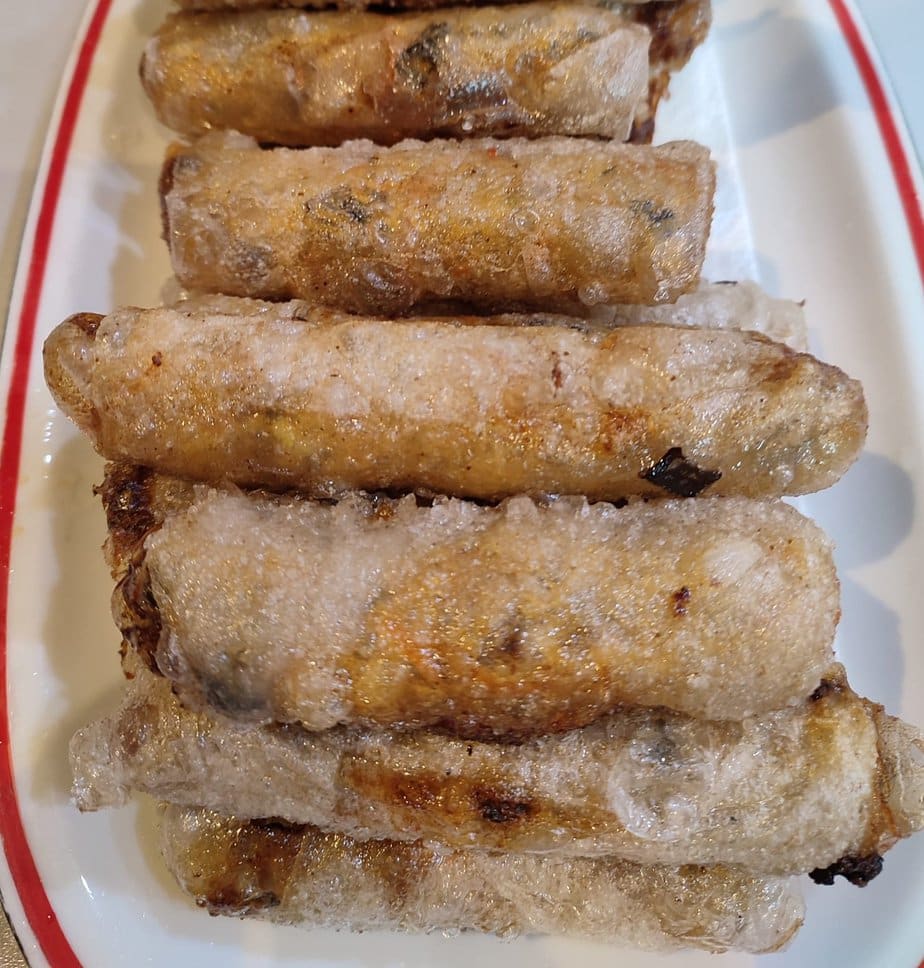
Tips for making a successful homemade Bo Bun
The key to savoring a divinely delicious Bo Bun lies in the attention paid to preparing homemade ingredients: Vietnamese pickled vegetables “do chua”, whose freshness and balance between sweetness and acidity provide a captivating flavor base; carefully made spring rolls, whose crispiness and depth of flavor far surpass ready-to-eat versions.
Not to mention the nem sauce, a true elixir that, with its harmonious combination of sweetness, umami, and spiciness, acts as the beating heart of the dish, enveloping each component and uniting them in a symphony of flavors.
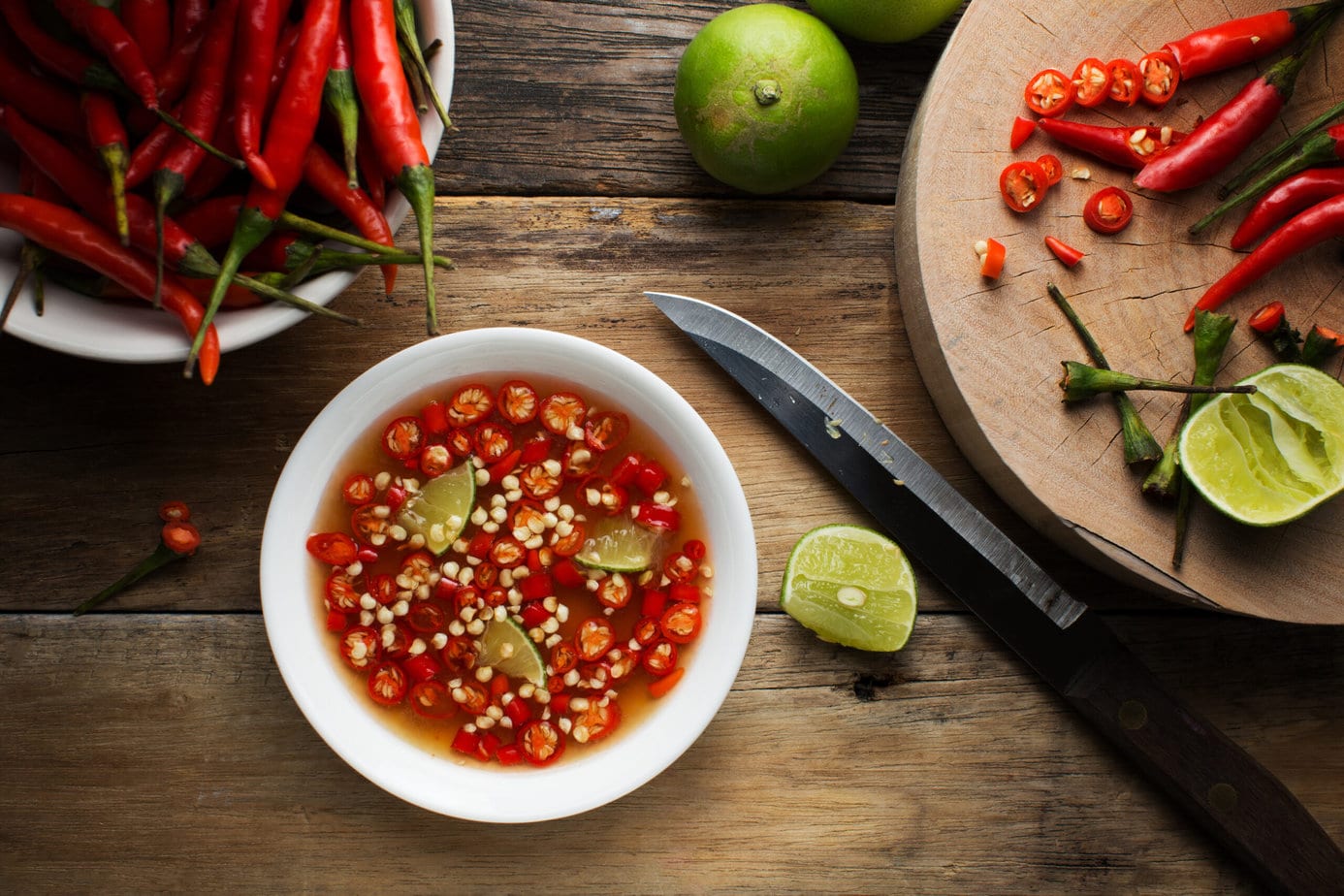
By opting for homemade ingredients, each bite of Bo Bun becomes an enriching experience that celebrates the authenticity and richness of Vietnamese cuisine.
The main ingredients of Bo Bun
Cooked spring rolls: Add crunch to the dish and complement the beef with their savory filling. They can be pork or chicken spring rolls
Rice vermicelli: These light noodles form the base of Bo Bun and wonderfully absorb the sauce and flavors of the other ingredients.
Lemongrass: Used in the marinade, it gives a fresh and lemony note to the meat.
Fish sauce: A key element of the marinade, it infuses the meat with a salty umami flavor.
Oyster sauce: Adds additional richness and complexity to the marinade.
Palm sugar: Balances the salty flavors of the marinade with a subtle sweetness.
Bean sprouts: Bring crunch and a fresh flavor to the toppings.
Mint leaves: Add an herbal freshness that balances the rich flavors of the dish.
Cilantro leaves: Complement the herbs by adding a spicy fresh note.
Vietnamese pickled vegetables (do chua): Introduce a pleasant acidity that balances the richness of the meat and sauces.
Fried onions (or shallots, or garlic): Provide a crispy texture and additional flavor to the dish.
Nuoc cham (nem sauce): This is the sauce that binds all the ingredients together, with a blend of sweet, salty, and sour flavors. It is generously poured over the noodles before adding the other ingredients.
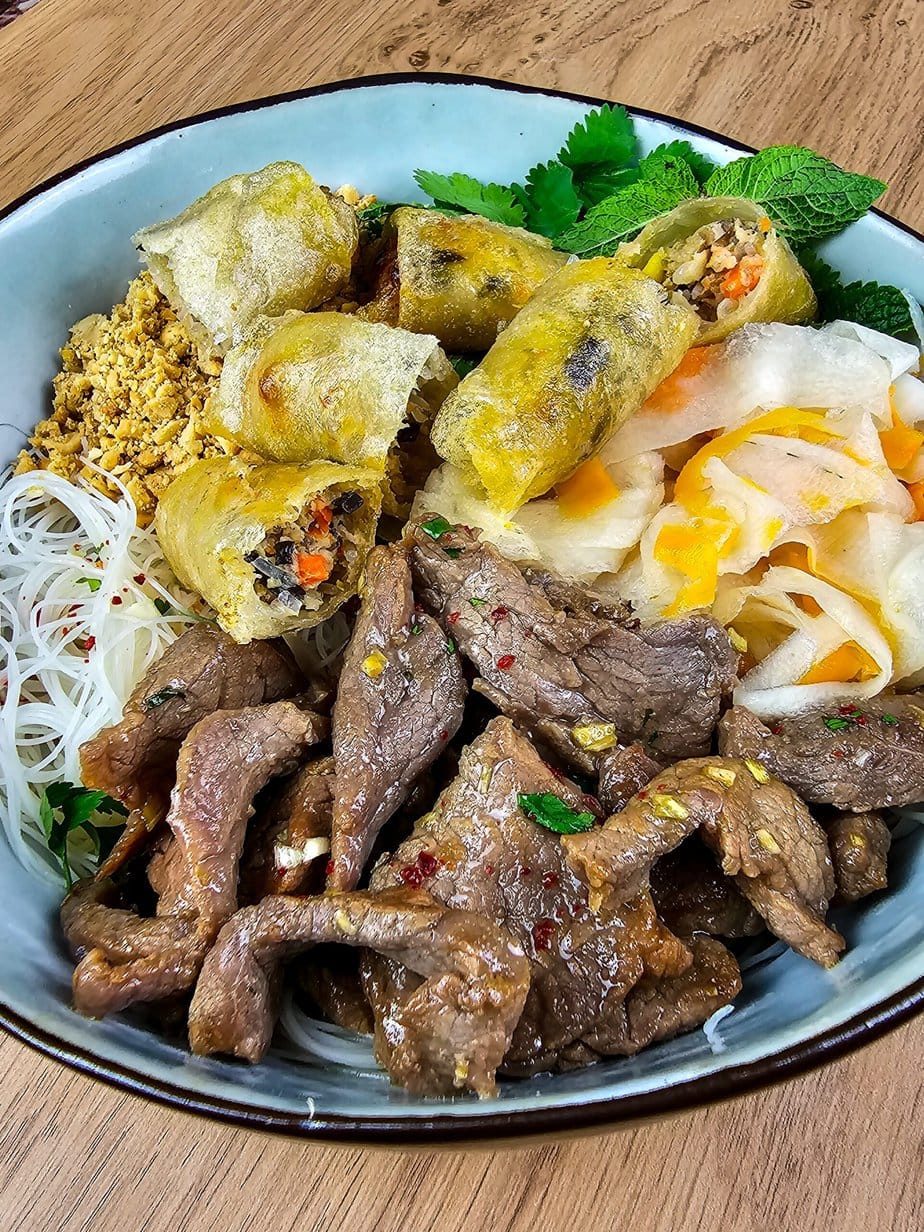
Authentic Vietnamese Bo Bun
Equipment
- 1 Wok
- 1 mortar
Ingredients
- 400 g thinly sliced beef
- 10 cooked spring rolls
- 200 g rice vermicelli dry weight
Marinade
- 5 stems of minced lemongrass see notes on how to prepare it
- 3 cloves of crushed garlic
- 2 tablespoon of fish sauce
- 2 tablespoon of oyster sauce
- 2 teaspoon palm sugar
Toppings
- 2 handles of bean sprouts
- 2 sprigs of mint leaves only
- 2 sprigs of cilantro leaves only
- 2 handles of Vietnamese pickled vegetables do chua
- 1 julienned cucumber
- 2 tablespoons of crushed peanuts
- 2 tablespoons of fried onions or shallots, or garlic
- 4 tablespoons of nuoc cham spring roll sauce
Instructions
- Cut the meat into strips
- Marinate the meat for 30 minutes
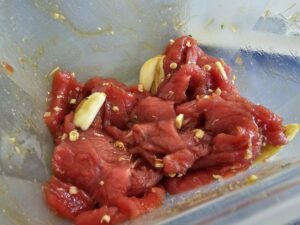
- Cook the vermicelli according to package instructions, cool and set aside
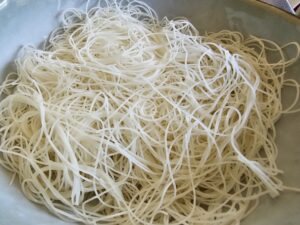
- If necessary, prepare the spring roll sauce according to my recipe as well as the Vietnamese pickled vegetables
- Crush the peanuts
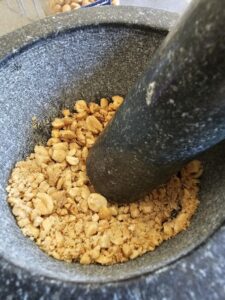
- Sauté the meat over medium-high heat in a little oil until desired doneness. Don’t forget to remove the two garlic cloves beforehand
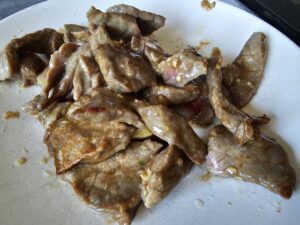
- In a bowl, add in this order: noodles, spring roll sauce, meat, and top with the rest of the toppings. Mix before eating
Notes
Don’t feel like making pickled vegetables? Just use grated carrot and cabbage
Nutrition
Culinary sources
- Saigoneer – Hanoi Ngõ Nooks: Cô Thoa’s Bún Bò Nam Bộ (2018) – On the Hanoi version of the dish and the legend of its origin – SAIGONEER.COM
- Kenh14 News – Controversy over the origin of bún bò Nam Bộ (2020) – On the controversies of the dish’s origin and evolution – KENH14.VN
- Tuổi Trẻ Online – Bún bò Nam Bộ in Hanoi: Created by Northerners or Southerners? (2024) – Interviews on history and regional differences – TUOITRE.VN
- Vietnamese Wikipedia – Bún bò Nam Bộ – On ingredients and the history of the name – VI.WIKIPEDIA.ORG
- VnExpress (Cooking) – How to make/Tips for Bún Bò Nam Bộ – Authentic recipes and advice on sauce and sautéing technique – VNEXPRESS.NET
- Indochina Voyages Blog – Diary of a Hanoian food-lover: Bun Bo Nam Bo – Balance of ingredients and a renowned restaurant in Hanoi – INDOCHINAVOYAGES.COM
- Reddit – r/VietNam, r/AskCulinary – Criteria for good bún bò Nam Bộ (herbs, local vs. foreign presentation) – REDDIT.COM
- Thien Lan’s Blog – Bo Bun Recipe (a Vietnamese-French home recipe) – Family adaptation with traditional elements and shortcuts – THIENLAN.ME
- Vietnamnet / Báo Hải Dương – The unexpected origin of bún bò Nam Bộ – Recognition by CNN and theories on the origin – VIETNAMNET / BÁO HẢI DƯƠNG
